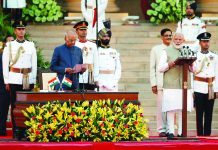 The National Crime Records Bureau (NCRB) data released recently throws light on why Hathras incident where a young Dalit girl was gang raped and finally done to death in a brutal manner. The NCRB data shows a rise of over seven per cent in crimes against women in the country in 2019.
The National Crime Records Bureau (NCRB) data released recently throws light on why Hathras incident where a young Dalit girl was gang raped and finally done to death in a brutal manner. The NCRB data shows a rise of over seven per cent in crimes against women in the country in 2019.
The 19 year old had died in Delhi’s Safdarjung Hospital after being allegedly gang raped and tortured by a group of upper caste men. The NCRB’s ‘Crime in India’ 2019 report showed how common crimes against women witnessed a steep rise across the country. A total of 4,05,861 cases of crime against women were registered during 2019, showing an increase of 7.3 per cent over 2018. The report shows that every 16 minutes, a woman is raped somewhere in India.
Another startling finding of the NCRB report is that a majority of those arrested by the UT police under the Indian Penal Code (IPC) and Special and Local Laws (SLLs) during 2019 were in the 18-30 age group.
According to a report of the National Crime Records Bureau (NCRB), of the 4,500 persons arrested, 59.97 per cent were in this age group. Among the 4,500 arrests, 2,562 were arrested for crime under the IPC.
Among them, 1,314 were in the 18-30 age group. As many as 1,938 persons were arrested for crime under various SLLs. Among them, 1,385 were in the 18-30 age group. A total of 2,699 arrested persons of the 4,500 were in this age group, which works out to 59.97 per cent.
Related to it is the NCRB report stating that in 2019, 528 children — 226 boys and 302 girls — were missing. Of them, 326 — 159 boys and 167 girls — were missing since previous years, while 202 — 135 girls and 67 boys — went missing in 2019. By the end of the year, only 172 children — 113 girls and 59 boys — were recovered or traced. A total of 356 minors — 167 boys and 189 girls — could not be traced.
Coming back to why Hathras was slated to happen is the fact that in 2019, the country had recorded 88 rape cases every day. Of the total 32,033 reported rape cases in the year, 11 per cent were from the Dalit community. The data shows that ‘Assault on Women with Intent to Outrage her Modesty’ were about 21.8 per cent). The crime rate registered per lakh women population is 62.4 in 2019 in comparison with 58.8 in 2018, the data shared by NCRB showed.
The latest data shows that maximum rape cases are reported from Rajasthan and Uttar Pradesh. Uttar Pradesh and Rajasthan have seen a rise in sexual violence as a tool of oppression against Dalit communities. Of all the reported rape cases in Uttar Pradesh, 18 per cent victims are Dalit women, almost double of that in Rajasthan (9 per cent).
The rate of crime against women too has shown a rise of over 3.5 per cent in one year. The NCRB report said the crime rate registered per lakh women population was 62.4 in 2019 compared to 58.8 in 2018.
According to the NCRB data, Uttar Pradesh accounted for 14.7 per cent of all registered crimes against women with 59,853 cases. Uttar Pradesh was followed by Rajasthan with 10.2 per cent share in all-India crimes against women and 41,550 cases. Overall, India recorded a total of 4,05,861 cases of crime against women in 2019 compared to 3,78,236 cases in 2018.
In terms of absolute numbers, Uttar Pradesh reported the highest number of cases. UP reported the highest number of crimes against women (59,853), accounting for 14.7 per cent of such cases across the country. It was followed by Rajasthan (41,550 cases; 10.2 per cent) and Maharashtra (37,144 cases; 9.2 per cent).
Assam reported the highest rate of crime against women at 177.8 (per lakh population), followed by Rajasthan (110.4) and Haryana (108.5). Rajasthan reported the highest number of rapes with 5,997 cases, followed by UP (3,065) and Madhya Pradesh (2,485). UP also had the highest number of crimes against girl children under the POCSO Act with 7,444 cases, followed by Maharashtra (6,402) and MP (6,053). The highest rate of these crimes were in Sikkim (27.1 per lakh population), MP (15.1), and Haryana (14.6).
UP had the highest number of dowry cases (2,410), at a rate of 2.2 (per lakh population), followed by Bihar (1,120). According to the report, 150 acid attacks were reported in 2019, of which 42 took place in UP and 36 in West Bengal. The report, which runs into three volumes and is over 1,500 pages, says a total of 45,935 cases were registered as crime against Scheduled Castes (SCs), “showing an increase of 7.3 per cent over 2018 (42,793 cases)”.
“Crime rate registered showed an increase from 21.2 (per lakh population) in 2018 to 22.8 in 2019. Crime head-wise cases revealed that simple hurt with 28.9 per cent (13,273 cases) formed the largest chunk of cases of crimes/ atrocities against Scheduled Castes during 2019. It was followed by cases under SC/ST (Prevention of Atrocities) Act with 9.0 per cent (4,129 cases), and cases under rape with 7.6 per cent (3,486 cases),” says the report.
UP reported the most cases against Scheduled Castes — 11,829 cases, accounting for 25.8 per cent of the cases across the country. It was followed by Rajasthan (6,794 cases; 14.8 per cent) and Bihar (6,544; 14.2 per cent). However, the rate of such cases was highest in Rajasthan at 55.6 (per lakh population), followed by MP (46.7) and Bihar (39.5).
Rajasthan also had the highest number of rapes against Dalit women (554), followed by UP (537) and MP (510). The rate of rape against Dalit women was highest in Kerala at 4.6 (per lakh population), followed by MP (4.5) and Rajasthan (4.5). There are women specific laws in the country including, the Prohibition of Child Marriage Act, 2006, Special Marriage Act, 1954, Dowry Prohibition Act, 1961, Indian Divorce Act, 1969, Maternity Benefit Act,1861, Medical Termination of Pregnancy Act,1971 and Sexual Harassment of Women at Workplace (Prevention, Prohibition and Redressal) Act, 2013 but these have proved to be insufficient.
Verma panel report
Justice Verma Committee was constituted to recommend amendments to the Criminal Law so as to provide for quicker trial and enhanced punishment for criminals accused of committing sexual assault against women. The Committee submitted its report on January 23, 2013. It suggested reforms in management of cases related to crime against women. Its suggestions included that a Rape Crisis Cell should be set up. The Cell should be immediately notified when an FIR in relation to sexual assault is made. The Cell must provide legal assistance to the victim. All police stations should have CCTVs at the entrance and in the questioning room. A complainant should be able to file FIRs online. Police officers should be duty bound to assist victims of sexual offences irrespective of the crime’s jurisdiction.
Members of the public who help the victims should not be treated as wrong doers. The police should be trained to deal with sexual offences appropriately. Number of police personnel should be increased. Community policing should be developed by providing training to volunteers.
The Committee recommended the amendment of the Representation of People Act, 1951. Currently, the Act provides for disqualification of candidates for crimes related to terrorism, untouchability, secularism, fairness of elections, sati and dowry. The Committee was of the opinion that filing of charge sheet and cognizance by the Court was sufficient for disqualification of a candidate under the Act. It recommended that candidates should be disqualified for committing sexual offences. When these reforms percolate down to ground is yet to be seen.
letters@tehelka.com













